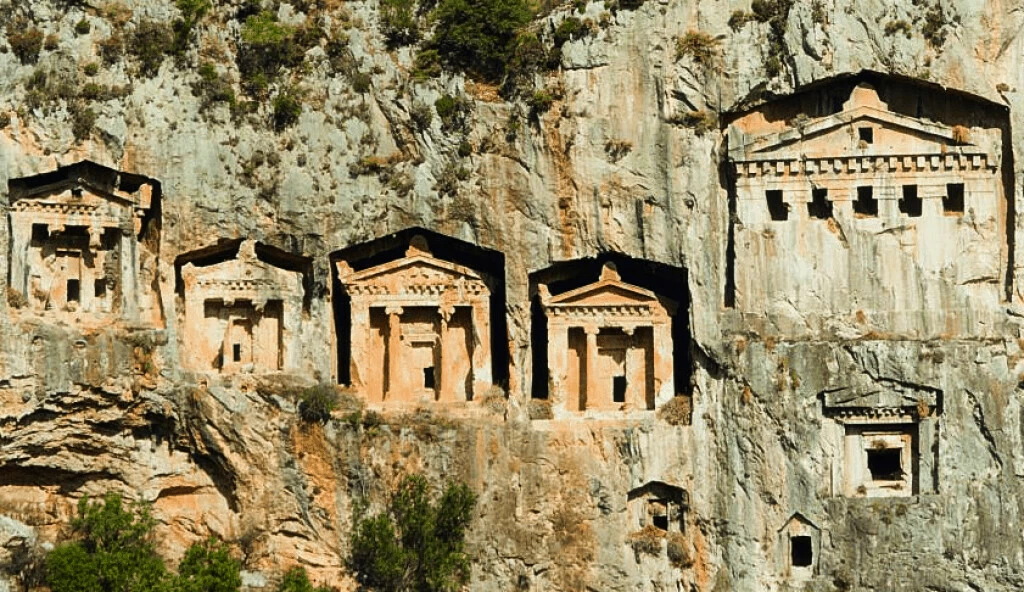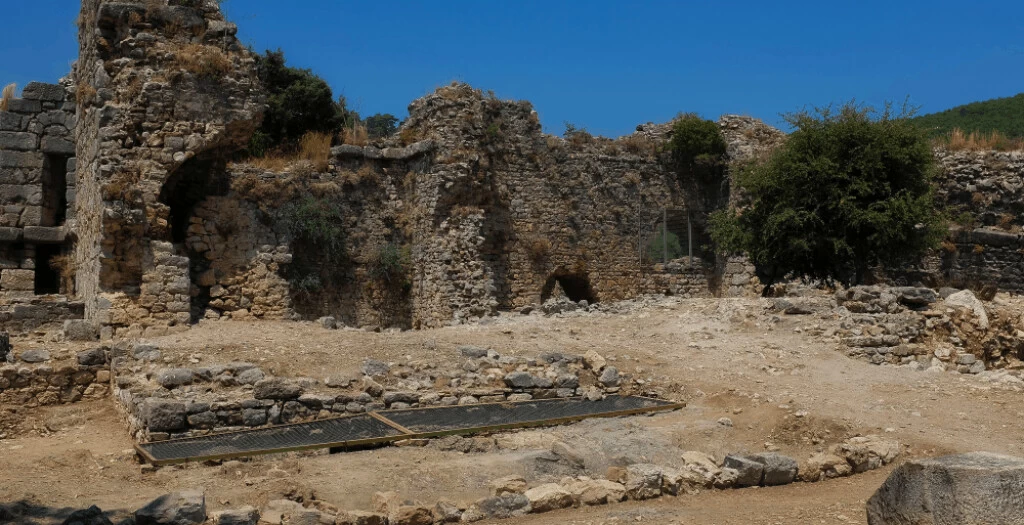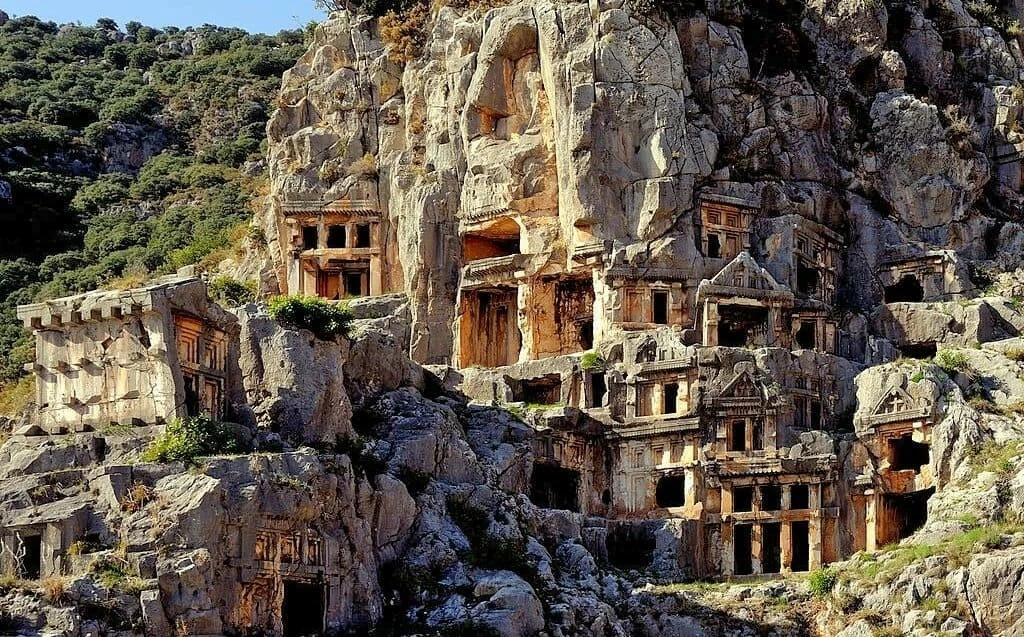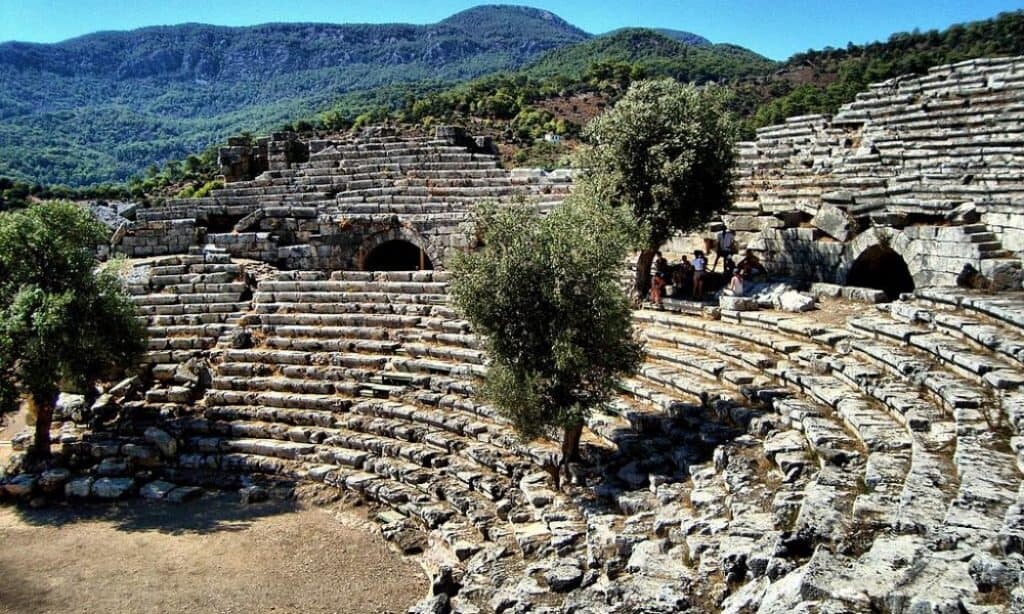Kaunos was once a thriving port city in Southwestern Anatolia near Dalyan, Turkey, between the Mediterranean and Aegean seas. Its ruins tell a tale of a rich and opulent history with its many archaeological structures and elegant Kaunian rock-cut tombs. Life in this port city dates back to the tenth century BCE. However, it was finally abandoned around 1500 CE. Today, the site reveals a multi-cultural tapestry of life that once occupied this area.

Legend of Caunus and Byblis
There are different versions of the legend, however, they all have to do with the incestuous love of Caunus and his twin sister, Byblis. Caunus was the son of Miletus and Eidothea, daughter of the Carian king, Eurytus. Byblis fell in love with her brother. But when she declared her love, Caunus rejected her and ran away to a far off land. He named that land Kaunos. In her desperate passion, she went to look for him but had no luck in changing his heart. She wept many tears of despair that became the Dalyan River.
A Brief History of Kaunos
Human activity in this region dates back to around the tenth century BCE. The Kaunians settled there beginning around the sixth century BCE. But real architectural structures did not surface until around the fourth century BCE. The Greek historian, Herodotus, wrote that he believed the Kaunians were the indigenous people of the region. Their language and culture indicated that they had a close association with their neighbors, the Carians. However, Herodotus pointed out differences between the two cultures in their social customs.
Kaunos peaked during a time of expanding maritime trade. It was in a strategic place between the two seas, and there were many desirable goods at Kaunos that could provision a long overseas journey. They traded dried fish, salt, dried figs, agricultural products, materials for shipbuilding and repair, and slaves. Many governments wanted control of this wealthy port city. Thus, it changed political hands many times during its existence.
From roughly 500 BCE to 600 CE this port city flourished. It was conquered repeatedly by different forces until the Romans finally took control around 85 BCE. Eventually, the inhabitants abandoned the city circa 1500 CE, and it lay forgotten for roughly 500 years.
You May Also Like: The Ancient History of Pompeii
Although scholars knew about it from old texts, they were never able to find it. That was until a British Naval Officer, R. Hoskyn, discovered it in 1842. Since then, archaeologists have been uncovering the city’s melting pot of cultural influences and artifacts.
Chronology of Rulership
-In 546 BCE, Persian forces, led by general Harpagos conquered the area.
-In 480 BCE Greek forces beat the Persians at the Battle of Salamis. Kaunos became a part of the Delian League bringing them under the governance and protection of Athens.
-In the fourth century BCE, the Persian Hecatomnos regained rule. The city merged with its neighbor, Caria.
-In 334 BCE, Alexander the Great conquered the region under the Macedonian Empire.
-After Alexander’s death, his generals and family fought over the empire, and the region changed hands a few times.
-In 189 BCE the Roman took over and put Rhodes in charge of the region. It then fell out of Roman rule and then back in again multiple times. During this same century, Kaunos became a part of Lycia, once an independent state to the east.
-In 85 BCE Romans placed the region back under the governance of Rhodes. It remained in the Roman Empire until the thirteenth century.
-Between the thirteenth and the fifteenth centuries, Turkish forces invaded and eventually took the whole region.
Decline of Kaunos
The Dalyan Delta had been depositing large quantities of silt at the ports over time, and a large amount of landmass was added to the original coastline. This slowed and eventually stopped all maritime trade and the city became impoverished. Muslim groups and raiders began attacking the area from about 600 CE. After the Turkish invasion in the fifteenth century, swamps caused a malaria epidemic, and Kaunos was abandoned for good. The city fell victim to the forces of time, erosion, and destructive earthquakes. Then Hoskyn, who worked for the British Navy surveying the coastlines and waters of the region, discovered it in 1842, as noted.
Archaeological Finds
Although there have been many fascinating discoveries, the following are the most impressive.
- Theater (above) dated circa second century BCE. Its capacity was 5000 people. A large wall supported one side of the theater, while the other half was built into the hillside. An innovative periaktos, a device that allows for revolving and rapid change of scenes (sets), also existed at this theater – perhaps the oldest one of its kind.
- Acropolis on a high peak 152 meters above sea level.
- Basilica (church) built at the center of the palaestra terrace.
- Monopteros. a circular colonnade supporting a roof but without any walls.” Ancient Greeks used a monopteros to view a famous deity placed in the center. The one found here housed a female deity and dates to around the first century CE.
- Wind-measuring platform dating back to about 150 BCE. This tool helped engineers design the city according to the direction of the wind to maximize airflow and maintain fresh, clean air.
- Roman baths, circa 85 BCE, where scientists found an exercise area, a sweating room, a warm room, and a cold pool.
- Agora from the Hellenistic Period with a stoa or long columned walkway. There were also many statues of different figures that sat atop stone platforms decorating the agora, along with a fountain.

Temples
Lesser Acropolis was built on an auspicious spot overlooking both harbors. It served as a religious site with a church and two temples. They designed it for the cult worship of the female fertility goddess Demeter. Every year, the Kaunian women would meet here for a three-day fertility festival in the hope that the Goddess would grant them a child. There was also a temple dedicated to Zeus from the first century BCE and a sixth-century church with a dome roof. An area dedicated to Apollo was once a sacred zone where the indigenous residents worshiped their god, Baselius Kaunios, from the fourth century BCE to the middle of the Roman Period. Scientists also found steles and statue bases for votives here.
Kaunian Rock Cut Tombs
Outside the city walls like brilliant marquees along the Dalyan River are the Hellenic Kaunian rock-cut tombs. Dating back to the 5th through 2nd centuries BCE, the tombs showcase temple-like facades on the sheer cliffsides. Between Dalyan and Kaunos there are more than 150 rock-cut tombs. Twenty of them have temple-type facades. Behind the facades are modest cut-out spaces of different sizes designed for housing the remains of families. The famous tombs facing the Dalyan River were undoubtedly for the elite. Some people say these are the Kaunosian kings’ tombs. Slabs of rocks served as doors to the inner chambers.
[blockquote align=”none” author=”Permanent Delegation of Turkey to UNESCO”]The façades of the rock-cut tombs resemble the fronts of Hellenistic temples with two Ionian pillars, a triangular pediment, an architrave with toothed friezes, and acroterions shaped like palm leaves, which demonstrates an interaction among different cultures finally reflected on a new and unique architectural style.[/blockquote]
Lycian Rock-Cut Tombs
Kaunian rock-cut tombs are highly unique. However, they are conceptually similar to the larger culture of Lycian rock-cut tombs that riddle Southern Anatolia, roughly from Caria to Etenna. A recent count revealed 1,085 Lycian tombs that remain intact. The biggest difference between the rock-cut tombs of the various Lycian regions is the facades. Kaunian rock-cut tomb facades present the most elaborate with a clear Greek Hellenic style. In general, the rock-cut tombs of Lycia are a clear testament to the multi-cultural influences of the region.
You May Also Like: The Mysterious Hanging Coffin Tombs in China

Kaunos, once a bustling destination city that overlooked over two prosperous maritime ports, now lies in scattered ruins. It is now approximately eight kilometers from the sea. There are no longer governments battling over control of the city; once it proved barren, no longer capable of filling large coffers, it was forgotten. But the work of archaeologists from across the world is revealing that today, the real treasure lies in its magnificent history.
